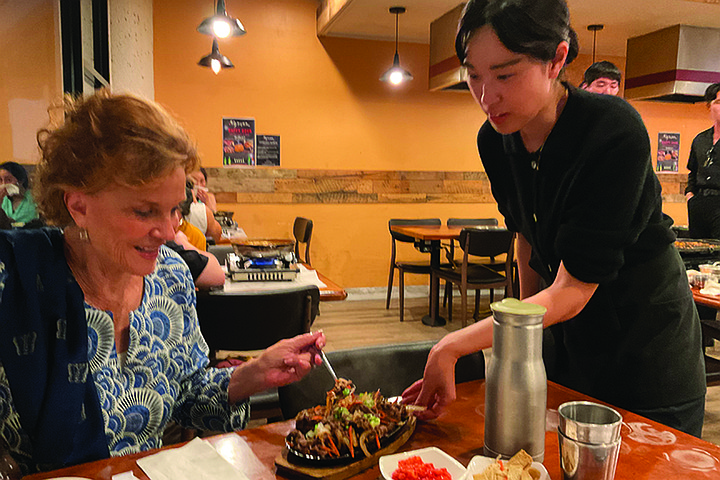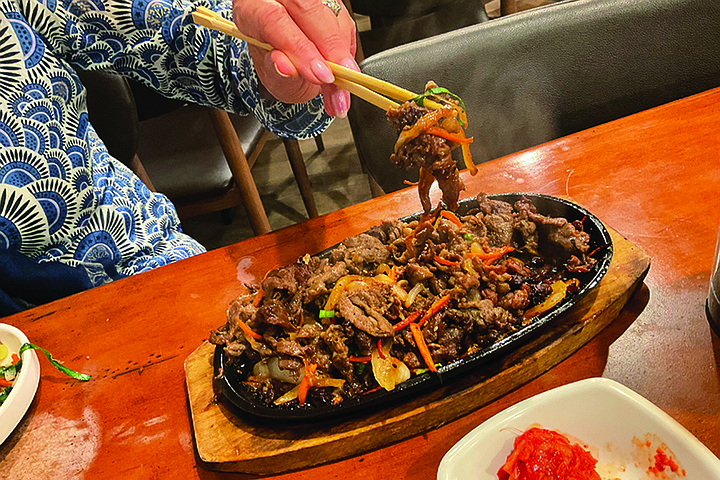 Facebook
Facebook
 X
X
 Instagram
Instagram
 TikTok
TikTok
 Youtube
Youtube

“Think globally, drink locally,” says this one guy’s T-shirt. And people are sure obeying that law here. Whole long table of mostly guys, back from a sport fishing trip and whooping it up. “That’s one thing about Koreans,” says Diana. “They know how to have fun.”
As for us, we consider ourselves lucky. We’ve been up here in Little Seoul, looking for a Korean joint that’s not closing down at 9 o’clock. Funny thing: all of them around here get done early. And the one which doesn’t, RakiRaki (it’s often open till two), has a practically hour-long waiting list. And besides, it’s really Japanese.

I’m with Diana. (OK, for clarity’s sake, this is not Diane, my beloved intended. She’s down in New Zealand on a work contract). And just-good-friends Diana and I share this hankering for things Asian. Specially food. She spent part of her childhood actually in Korea, so finding a Korean joint is personal. “Let’s split up till we find one that’s open,” she says. I search around Convoy, find everybody closing, finally come across Diana deep in conversation with a couple of Korean students inside this Korean — and open! — place called Song Hak (“The Pine Tree”). “My parents and I lived aboard a cargo ship in Korea when I was three,” she’s telling them. “They were troubled times, but I loved my life there. I fit in with the culture, the cuisine. Korean food became my comfort food.” Because yes, she has had one adventurous life, half of it eating Korean nosh. The students are juiced by the fact she knows so much.
“They call the Koreans ‘the Irish of the East,’” she tells me when they go back to their table. “Or sometimes, ‘the Italians of the East,’ because Koreans are party-loving people. And they are so-oo musical. How many times did I see little kids like me over there, propped up on four phone books at the piano, playing Beethoven? Or, ever hear of K-Pop? BTS?” Hey. This lady is tuned in. Foodwise, too. She hankers for basic Korean. “Koreans are the original garlic eaters!” she says. “Barbers in Seoul wear baffles so they don’t breathe over you while they cut your hair! And kimchi? Don’t get me going. Kimchi saved Koreans from starvation, back in the bad old days, just as sauerkraut saved the Germans, because they both learned to preserve cabbage without refrigeration, by salting and fermenting. The Koreans bury cabbage in clay pots to marinate. They make winter kimchi, spring kimchi, summer kimchi, fall kimchi. I miss it so!”

It’s about now that Eunjin (“Jiny”) comes up to get our orders. The menu is big, but of course the one everybody has heard of is bulgogi (“fire meat”). It’s “sweet marinated thin sliced beef” with “side dishes and rice,” $16.99. Kimchi fried rice is $15.99, dwenhang chigae — basically, bean paste stew with beef brisket — is about the cheapest meal at $13.99. Oh, but the one with my favorite name, bibimbop — a rice bowl mixed with veggies and egg over easy on top — also comes out at $13.99. And so does soontofu stew: “Korean famous soft tofu stew,” the menu says. Beef intestines, beef brisket and sausage. Also $13.99. Sizzling stone pot rice and a half teok galbi dolsot turns out to be a grilled beef short rib patty. Most dishes you can add meat to for $5. And this dish comes in on track at $18.99.
Hmm. Choices. Koreans love their meat. And their marination. But time’s a-flying. Diana and I feel the pressure. Even the sport fishing crowd is leaning back and taking a breath. I kinda look to her as the expert. But we somehow end up making a mistake: we get two beef dishes, the bibimbop with bulgogi ($20.99), and a bulgogi meal ($18.99).

Yes, they’re good: not very spicy, but tasty. And yet, with all the choices on the menu, we know we blew it. “Two beef dishes. At least we could have had pork in one,” says Diana. We both look kind of longingly at the wild long table next door, where the fishing party is back whooping it up with a regular stream of chilly Korean Cass beer, and what seems like a regular procession of sizzling dishes that bubble over the blue flames as the guys (mainly) fill their bowls, laugh, shout, sing. Eunjin and the crew bring them pork belly and brisket, kalbi (short ribs), fried rice that has been cooked in dishes that have already been flavored by other meats ($7.99), and countless sides, including variations of kimchi. Between toasting, eating, drinking and joshing, this table doesn’t stop rocking. Next time, we swear, we’re coming back with twenty of our best friends for one of these nights of revelry, Korean-style.
One thing we do get, though, is complimentary sides (the Koreans are always big on free sides), specially of kimchi. Slightly sweet, plenty vinegary. “They say kimchi is good for warding off diseases,” says Diana. “This is the taste of my childhood. We should have got it as a main dish. Ooh, and I should have had this.” She’s looking at a menu item under “Famous Korean glass noodles.” “Japchae,” she says, “‘with chopped pork lion and vegetables, $18.99.’”
“‘Chopped lion,’ huh?” I ask. It’s a misprint of course: should be “loin.” The point is, the meat’s in a sea of glass noodles.
“Korean glass noodles are what I’d take with me to a desert island,” Diana says. “They were the comfort food, the mac’n cheese of my childhood. We’re coming back, okay?”
“Us and, don’t forget, 20 of our closest friends,” I reply.


“Think globally, drink locally,” says this one guy’s T-shirt. And people are sure obeying that law here. Whole long table of mostly guys, back from a sport fishing trip and whooping it up. “That’s one thing about Koreans,” says Diana. “They know how to have fun.”
As for us, we consider ourselves lucky. We’ve been up here in Little Seoul, looking for a Korean joint that’s not closing down at 9 o’clock. Funny thing: all of them around here get done early. And the one which doesn’t, RakiRaki (it’s often open till two), has a practically hour-long waiting list. And besides, it’s really Japanese.

I’m with Diana. (OK, for clarity’s sake, this is not Diane, my beloved intended. She’s down in New Zealand on a work contract). And just-good-friends Diana and I share this hankering for things Asian. Specially food. She spent part of her childhood actually in Korea, so finding a Korean joint is personal. “Let’s split up till we find one that’s open,” she says. I search around Convoy, find everybody closing, finally come across Diana deep in conversation with a couple of Korean students inside this Korean — and open! — place called Song Hak (“The Pine Tree”). “My parents and I lived aboard a cargo ship in Korea when I was three,” she’s telling them. “They were troubled times, but I loved my life there. I fit in with the culture, the cuisine. Korean food became my comfort food.” Because yes, she has had one adventurous life, half of it eating Korean nosh. The students are juiced by the fact she knows so much.
“They call the Koreans ‘the Irish of the East,’” she tells me when they go back to their table. “Or sometimes, ‘the Italians of the East,’ because Koreans are party-loving people. And they are so-oo musical. How many times did I see little kids like me over there, propped up on four phone books at the piano, playing Beethoven? Or, ever hear of K-Pop? BTS?” Hey. This lady is tuned in. Foodwise, too. She hankers for basic Korean. “Koreans are the original garlic eaters!” she says. “Barbers in Seoul wear baffles so they don’t breathe over you while they cut your hair! And kimchi? Don’t get me going. Kimchi saved Koreans from starvation, back in the bad old days, just as sauerkraut saved the Germans, because they both learned to preserve cabbage without refrigeration, by salting and fermenting. The Koreans bury cabbage in clay pots to marinate. They make winter kimchi, spring kimchi, summer kimchi, fall kimchi. I miss it so!”

It’s about now that Eunjin (“Jiny”) comes up to get our orders. The menu is big, but of course the one everybody has heard of is bulgogi (“fire meat”). It’s “sweet marinated thin sliced beef” with “side dishes and rice,” $16.99. Kimchi fried rice is $15.99, dwenhang chigae — basically, bean paste stew with beef brisket — is about the cheapest meal at $13.99. Oh, but the one with my favorite name, bibimbop — a rice bowl mixed with veggies and egg over easy on top — also comes out at $13.99. And so does soontofu stew: “Korean famous soft tofu stew,” the menu says. Beef intestines, beef brisket and sausage. Also $13.99. Sizzling stone pot rice and a half teok galbi dolsot turns out to be a grilled beef short rib patty. Most dishes you can add meat to for $5. And this dish comes in on track at $18.99.
Hmm. Choices. Koreans love their meat. And their marination. But time’s a-flying. Diana and I feel the pressure. Even the sport fishing crowd is leaning back and taking a breath. I kinda look to her as the expert. But we somehow end up making a mistake: we get two beef dishes, the bibimbop with bulgogi ($20.99), and a bulgogi meal ($18.99).

Yes, they’re good: not very spicy, but tasty. And yet, with all the choices on the menu, we know we blew it. “Two beef dishes. At least we could have had pork in one,” says Diana. We both look kind of longingly at the wild long table next door, where the fishing party is back whooping it up with a regular stream of chilly Korean Cass beer, and what seems like a regular procession of sizzling dishes that bubble over the blue flames as the guys (mainly) fill their bowls, laugh, shout, sing. Eunjin and the crew bring them pork belly and brisket, kalbi (short ribs), fried rice that has been cooked in dishes that have already been flavored by other meats ($7.99), and countless sides, including variations of kimchi. Between toasting, eating, drinking and joshing, this table doesn’t stop rocking. Next time, we swear, we’re coming back with twenty of our best friends for one of these nights of revelry, Korean-style.
One thing we do get, though, is complimentary sides (the Koreans are always big on free sides), specially of kimchi. Slightly sweet, plenty vinegary. “They say kimchi is good for warding off diseases,” says Diana. “This is the taste of my childhood. We should have got it as a main dish. Ooh, and I should have had this.” She’s looking at a menu item under “Famous Korean glass noodles.” “Japchae,” she says, “‘with chopped pork lion and vegetables, $18.99.’”
“‘Chopped lion,’ huh?” I ask. It’s a misprint of course: should be “loin.” The point is, the meat’s in a sea of glass noodles.
“Korean glass noodles are what I’d take with me to a desert island,” Diana says. “They were the comfort food, the mac’n cheese of my childhood. We’re coming back, okay?”
“Us and, don’t forget, 20 of our closest friends,” I reply.